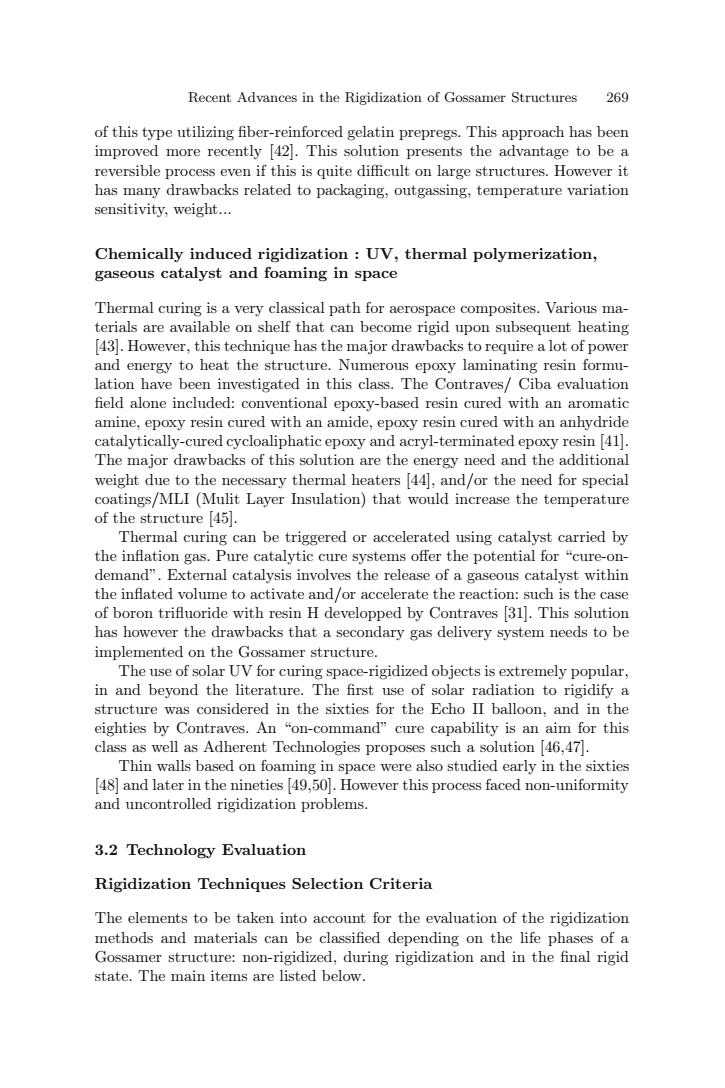正在加载图片...

Recent Advances in the Rigidization of Gossamer Structures 269 of this type utilizing fiber-reinforced gelatin prepregs.This approach has been improved more recently [42.This solution presents the advantage to be a reversible process even if this is quite difficult on large structures.However it has many drawbacks related to packaging,outgassing,temperature variation sensitivity,weight... Chemically induced rigidization UV,thermal polymerization, gaseous catalyst and foaming in space Thermal curing is a very classical path for aerospace composites.Various ma- terials are available on shelf that can become rigid upon subsequent heating [43].However,this technique has the major drawbacks to require a lot of power and energy to heat the structure.Numerous epoxy laminating resin formu- lation have been investigated in this class.The Contraves/Ciba evaluation field alone included:conventional epoxy-based resin cured with an aromatic amine,epoxy resin cured with an amide,epoxy resin cured with an anhydride catalytically-cured cycloaliphatic epoxy and acryl-terminated epoxy resin [41]. The major drawbacks of this solution are the energy need and the additional weight due to the necessary thermal heaters [44],and/or the need for special coatings/MLI(Mulit Layer Insulation)that would increase the temperature of the structure [45]. Thermal curing can be triggered or accelerated using catalyst carried by the inflation gas.Pure catalytic cure systems offer the potential for"cure-on- demand".External catalysis involves the release of a gaseous catalyst within the inflated volume to activate and/or accelerate the reaction:such is the case of boron trifluoride with resin H developped by Contraves [31.This solution has however the drawbacks that a secondary gas delivery system needs to be implemented on the Gossamer structure. The use of solar UV for curing space-rigidized objects is extremely popular, in and beyond the literature.The first use of solar radiation to rigidify a structure was considered in the sixties for the Echo II balloon,and in the eighties by Contraves.An "on-command"cure capability is an aim for this class as well as Adherent Technologies proposes such a solution [46,47. Thin walls based on foaming in space were also studied early in the sixties [48]and later in the nineties [49,50].However this process faced non-uniformity and uncontrolled rigidization problems. 3.2 Technology Evaluation Rigidization Techniques Selection Criteria The elements to be taken into account for the evaluation of the rigidization methods and materials can be classified depending on the life phases of a Gossamer structure:non-rigidized,during rigidization and in the final rigid state.The main items are listed below.Recent Advances in the Rigidization of Gossamer Structures 269 of this type utilizing fiber-reinforced gelatin prepregs. This approach has been improved more recently [42]. This solution presents the advantage to be a reversible process even if this is quite difficult on large structures. However it has many drawbacks related to packaging, outgassing, temperature variation sensitivity, weight... Chemically induced rigidization : UV, thermal polymerization, gaseous catalyst and foaming in space Thermal curing is a very classical path for aerospace composites. Various materials are available on shelf that can become rigid upon subsequent heating [43]. However, this technique has the major drawbacks to require a lot of power and energy to heat the structure. Numerous epoxy laminating resin formulation have been investigated in this class. The Contraves/ Ciba evaluation field alone included: conventional epoxy-based resin cured with an aromatic amine, epoxy resin cured with an amide, epoxy resin cured with an anhydride catalytically-cured cycloaliphatic epoxy and acryl-terminated epoxy resin [41]. The major drawbacks of this solution are the energy need and the additional weight due to the necessary thermal heaters [44], and/or the need for special coatings/MLI (Mulit Layer Insulation) that would increase the temperature of the structure [45]. Thermal curing can be triggered or accelerated using catalyst carried by the inflation gas. Pure catalytic cure systems offer the potential for “cure-ondemand”. External catalysis involves the release of a gaseous catalyst within the inflated volume to activate and/or accelerate the reaction: such is the case of boron trifluoride with resin H developped by Contraves [31]. This solution has however the drawbacks that a secondary gas delivery system needs to be implemented on the Gossamer structure. The use of solar UV for curing space-rigidized objects is extremely popular, in and beyond the literature. The first use of solar radiation to rigidify a structure was considered in the sixties for the Echo II balloon, and in the eighties by Contraves. An “on-command” cure capability is an aim for this class as well as Adherent Technologies proposes such a solution [46,47]. Thin walls based on foaming in space were also studied early in the sixties [48] and later in the nineties [49,50]. However this process faced non-uniformity and uncontrolled rigidization problems. 3.2 Technology Evaluation Rigidization Techniques Selection Criteria The elements to be taken into account for the evaluation of the rigidization methods and materials can be classified depending on the life phases of a Gossamer structure: non-rigidized, during rigidization and in the final rigid state. The main items are listed below